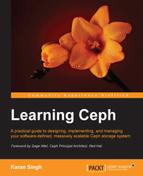Book Description
A practical guide to designing, implementing, and managing your software-defined, massively scalable Ceph storage system
In Detail
Ceph is an open source, software-defined storage solution, which runs on commodity hardware to provide exabyte-level scalability. It is well known to be a highly reliable storage system that has no single point of failure.
This book will give you all the skills you need to plan, deploy, and effectively manage your Ceph cluster, guiding you through an overview of Ceph's technology, architecture, and components. With a step-by-step, tutorial-style explanation of the deployment of each Ceph component, the book will take you through Ceph storage provisioning and integration with OpenStack.
You will then discover how to deploy and set up your Ceph cluster, discovering the various components and why we need them. This book takes you from a basic level of knowledge in Ceph to an expert understanding of its most advanced features.
What You Will Learn
- Understand the limitations of existing systems and the need to use Ceph as a storage solution
- Get to grips with Ceph's architecture and discover the different components of Ceph
- Perform instant deployment and testing of Ceph within a VirtualBox environment
- Familiarize yourself with Ceph operations such as maintenance, monitoring, and troubleshooting
- Implement storage provisioning in the form of Ceph's block, object, and filesystem
- Integrate Ceph with OpenStack Cinder and Glance components
- Discover advance topics in Ceph, including erasure coding, CRUSH map, and performance tuning, and learn best practices for your Ceph cluster
Downloading the example code for this book. You can download the example code files for all Packt books you have purchased from your account at http://www.PacktPub.com. If you purchased this book elsewhere, you can visit http://www.PacktPub.com/support and register to have the files e-mailed directly to you.
Table of Contents
- Learning Ceph
- Table of Contents
- Learning Ceph
- Credits
- Foreword
- About the Author
- About the Reviewers
- www.PacktPub.com
- Preface
- 1. Introducing Ceph Storage
- 2. Ceph Instant Deployment
- 3. Ceph Architecture and Components
- 4. Ceph Internals
- 5. Deploying Ceph – the Way You Should Know
- 6. Storage Provisioning with Ceph
- 7. Ceph Operations and Maintenance
- Ceph service management
- Running Ceph as a service
- Scaling out a Ceph cluster
- Adding OSD nodes to a Ceph cluster
- Scaling down a Ceph cluster
- Bringing an OSD out and down from a Ceph cluster
- Removing the OSD from a Ceph cluster
- Replacing a failed disk drive
- Manipulating CRUSH maps
- Identifying CRUSH locations
- CRUSH map internals
- Different pools on different OSDs
- Summary
- 8. Monitoring Your Ceph Cluster
- 9. Integrating Ceph with OpenStack
- 10. Ceph Performance Tuning and Benchmarking
- Index
